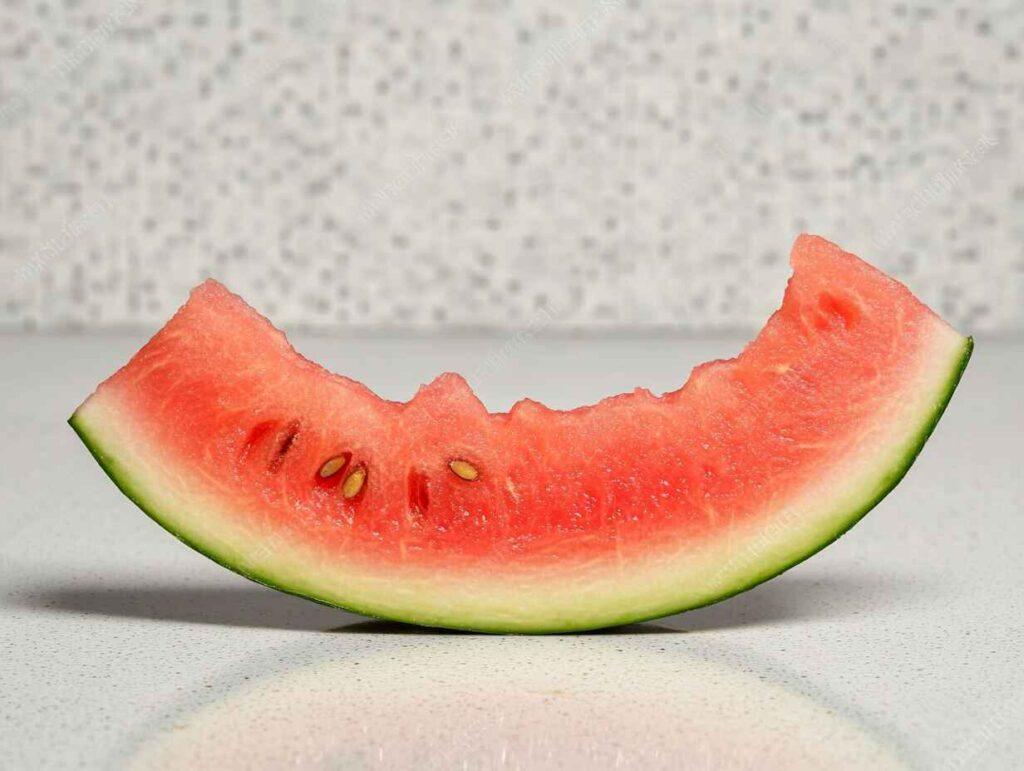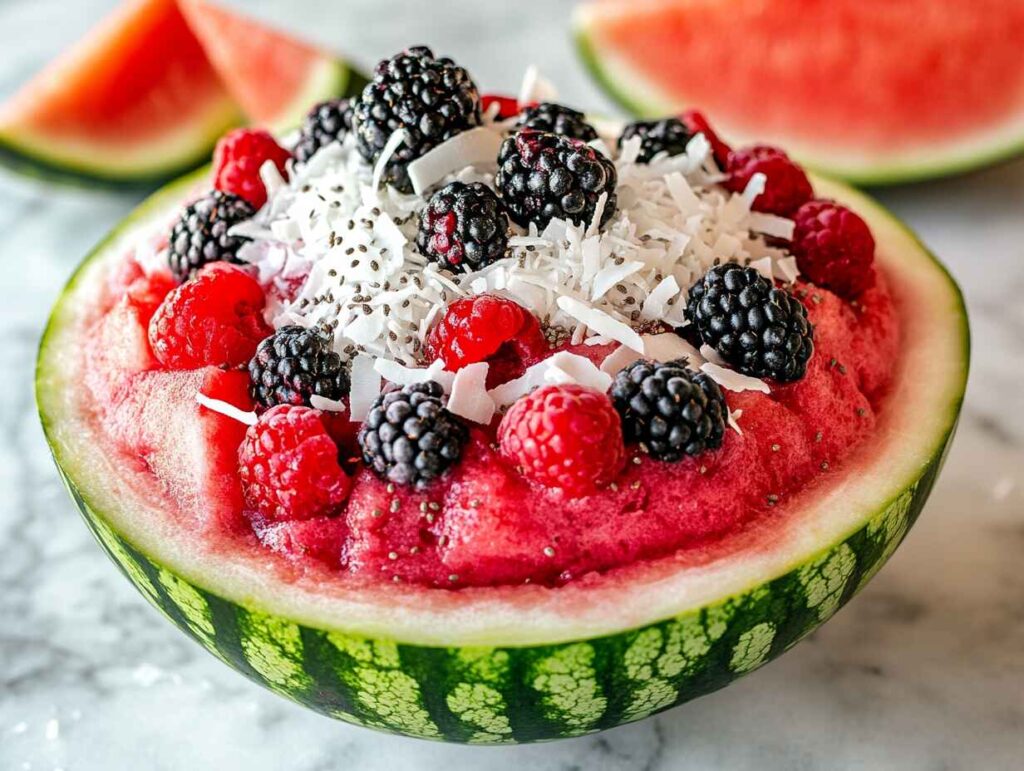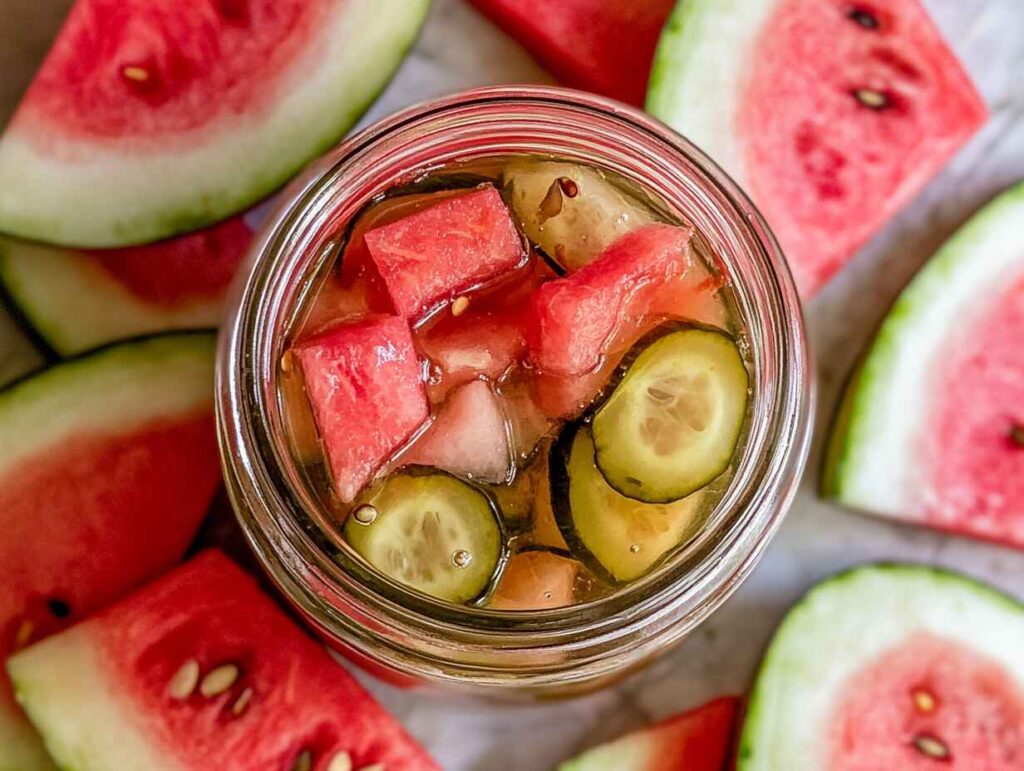Introduction
When you think of watermelon, the sweet and juicy red flesh probably comes to mind. But have you ever wondered about the rind? Most people discard this green-white layer without realizing its potential. In reality, watermelon rinds are packed with nutrients, incredibly versatile, and surprisingly delicious when prepared correctly.

From health benefits to creative culinary uses, this guide will show you why watermelon rinds deserve more love. By the end, you’ll be inspired to turn this often-overlooked part of the fruit into something amazing. 🍉
What Are Watermelon Rinds?
Anatomy of a Watermelon: What Is the Rind?
The rind is the green outer layer of a watermelon, found just beneath the skin and surrounding the juicy red flesh. It’s made up of a firm white layer that is slightly crunchy and contains subtle hints of sweetness. While the rind may seem unappealing at first, it’s actually edible and full of surprising uses.
Why Shouldn’t You Throw Away Watermelon Rinds?
Throwing away watermelon rinds is like tossing out a treasure chest of nutrients. Here’s why you should reconsider:
- Nutritional Value: Watermelon rinds are rich in vitamins B6 and C, as well as amino acids like citrulline, which promote good health.
- Sustainability: Reusing watermelon rinds helps reduce food waste, making it an eco-friendly choice.
- Culinary Potential: Rinds can be pickled, blended, or cooked into various dishes, adding unique flavor and texture to your meals.
Nutritional Powerhouse
Watermelon rinds may not be as sweet as the red flesh, but they hold their own when it comes to nutrients. They’re rich in vitamin C, which supports your immune system, and vitamin B6, which helps with brain function and energy production. Additionally, they’re a great source of fiber, aiding in digestion and keeping you full longer.
Fun Fact: The white part of the rind contains citrulline, an amino acid that can improve circulation and muscle recovery.
Sustainability Matters
Throwing away watermelon rinds contributes to food waste, which is a growing problem worldwide. By reusing rinds, you’re not only reducing waste but also embracing a more sustainable approach to food. Composting them is another eco-friendly option, as rinds decompose quickly and enrich the soil with valuable nutrients.
Pro Tip: Chop watermelon rinds into small pieces before adding them to your compost for faster breakdown.
Culinary Creativity
One of the best reasons to save watermelon rinds is their versatility in recipes. With a little creativity, they can be transformed into delicious dishes:
- Pickled Rinds: Sweet and tangy pickled rinds are a popular snack or condiment in many cuisines.
- Smoothies: Blend the rind into your favorite fruit smoothie for added nutrients and a refreshing texture.
- Stir-Fries: Use thinly sliced rind in a vegetable stir-fry for a crunchy twist.
The mild flavor of watermelon rind means it easily absorbs spices and seasonings, making it perfect for both sweet and savory recipes.
Easy Preparation
If you’re worried about the effort involved, don’t be! Preparing watermelon rinds is straightforward:
- Wash them thoroughly to remove any dirt or residue.
- Peel off the green outer skin if desired (it’s edible but tougher to chew).
- Slice, dice, or shred the white portion of the rind based on your recipe.
A Small Change, Big Benefits
By rethinking how you use watermelon rinds, you can reduce food waste, add more nutrients to your diet, and experiment with fun recipes. It’s a win-win for your health and the environment. So, next time you enjoy a slice of watermelon, remember: the rind is more than just the wrapper—it’s an ingredient waiting to shine. 🍉
Health Benefits of Watermelon Rinds
What Are Watermelon Rinds Good For?
Watermelon rinds aren’t just edible—they’re actually quite good for you! Here are some of their health benefits:
- Boosts Hydration: Just like the flesh, rinds contain a high water content, helping you stay hydrated.
- Supports Digestion: The fiber in rinds promotes healthy digestion and can alleviate constipation.
- Rich in Antioxidants: Vitamin C in the rinds helps combat free radicals, boosting your immune system.
- Aids Muscle Recovery: Citrulline, an amino acid found in the rind, helps reduce muscle soreness after exercise.
What Is the Healthiest Part of a Watermelon?
While most people assume the red flesh is the healthiest part of the watermelon, the rind holds its own when it comes to nutrients. The rind is lower in sugar than the flesh but packed with fiber, making it a great choice for those watching their sugar intake. Plus, the citrulline in the rind is beneficial for heart health and circulation.
Is Watermelon Rind a Laxative?
Yes, watermelon rind can act as a mild laxative due to its high fiber content. This makes it a natural remedy for constipation, helping to promote regular bowel movements. However, moderation is key—overeating may cause digestive discomfort.
For more ways to incorporate nutrient-rich vegetables into your meals, check out this Cheesy Garlic Zucchini Steaks Recipe.
How to Eat Watermelon Rinds
If you’re wondering how to incorporate watermelon rinds into your diet, the good news is that they’re versatile and easy to use. With a little preparation, you can turn this often-overlooked part of the fruit into something delicious.

Is Watermelon Rind Safe to Eat Raw?
Yes, watermelon rind is completely safe to eat raw! Its crunchy texture and mild flavor make it an excellent addition to salads, smoothies, or even as a standalone snack. However, it’s best to wash the rind thoroughly to remove any pesticides or dirt before consuming it raw.
Pro Tip: Slice the rind into thin strips and pair it with a dip like hummus for a refreshing snack.
How Do You Prepare Watermelon Rinds for Eating?
Preparing watermelon rinds is simple:
- Wash Thoroughly: Rinse the rind under cold water to remove dirt and residue.
- Peel the Outer Skin (Optional): While the green outer skin is edible, peeling it can make the rind easier to work with in recipes.
- Slice or Dice: Depending on your recipe, cut the rind into thin strips, cubes, or shreds.
Once prepped, the rind is ready to be cooked, pickled, or blended into your favorite dishes.
Creative Ways to Use Watermelon Rinds in Recipes
Watermelon rinds are incredibly versatile. Here are some creative ideas:
- Smoothies: Blend diced watermelon rind with fruits like banana and spinach for a nutrient-packed smoothie.
- Stir-Fries: Add thinly sliced rind to vegetable stir-fries for a crunchy texture.
- Pickles: Pickled watermelon rinds are tangy, sweet, and perfect as a side or snack.
- Salads: Toss shredded rind with carrots, cucumbers, and a light vinaigrette for a refreshing salad.
Try adding chopped rinds to smoothies or soups. For a refreshing drink idea, consider pairing rinds with the flavors of this Pineapple Mango Juice.
Block Quote:
“Watermelon rinds are a blank canvas in the kitchen—get creative and explore their full potential!”
What to Do with Watermelon Rinds
Once you’ve prepared your rinds, the possibilities are endless. Here are some of the most popular ways to use them:

Pickling Watermelon Rinds: A Tasty Option
Pickling is one of the easiest and tastiest ways to use watermelon rinds.
Quick Pickling Recipe:
- Peel the green skin and dice the rind.
- Boil a mixture of vinegar, sugar, and spices like cinnamon and cloves.
- Add the rind pieces to the mixture and let it simmer for 10 minutes.
- Cool and store in a jar.
These pickled rinds make a tangy snack or a delicious accompaniment to sandwiches and cheese boards.
Juices and Smoothies Using Watermelon Rinds
Blending watermelon rinds into juices or smoothies is a quick way to use them up. The high water content ensures a refreshing drink.
- Juice Idea: Combine watermelon rind, cucumber, mint, and a splash of lime juice for a cooling beverage.
- Smoothie Idea: Blend rind with pineapple, Greek yogurt, and honey for a creamy and nutritious smoothie.
Using Watermelon Rinds as Compost
If you’re not planning to eat the rinds, don’t toss them—compost them instead! Watermelon rinds decompose quickly and enrich the soil with valuable nutrients. Simply chop them into smaller pieces and add them to your compost bin.
Fun Fact: Composting watermelon rinds can help reduce food waste and support sustainable gardening.
Common Misconceptions About Watermelon Rinds
Watermelon rinds are often misunderstood. Let’s clear up some common myths and misconceptions about this underappreciated part of the fruit.
Do Watermelon Rinds Taste Bitter?
Many people assume watermelon rinds are bitter, but that’s not entirely true. While the green outer skin can have a slight bitterness, the white portion of the rind is mild and subtly sweet. When prepared properly—such as by peeling or cooking—the bitterness is virtually nonexistent.
Can You Freeze Watermelon?
Yes, you can freeze watermelon, including its rind! Freezing is a great way to preserve watermelon rinds for later use in recipes like smoothies or soups.
How to Freeze Watermelon Rinds:
- Peel the green skin and cut the rind into small pieces.
- Blanch the pieces in boiling water for 1-2 minutes, then transfer to an ice bath to stop the cooking process.
- Pat dry and store in an airtight container or freezer bag.
Frozen rinds can be kept for up to 6 months.
Why Do People Boil Watermelon Rinds?
Boiling watermelon rinds is a common step in many recipes, particularly for pickling or making jams. Boiling softens the rinds, making them easier to absorb flavors from spices and syrups. It also enhances their texture, turning them into a tender and flavorful addition to dishes.
Pro Tip: Add cinnamon sticks, ginger, or cloves to the boiling water for an aromatic twist.
FAQs About Watermelon Rinds
What Are Watermelon Rinds Good For?
Watermelon rinds are excellent for:
- Culinary Uses: From pickles to stir-fries, they’re versatile in recipes.
- Health Benefits: They provide hydration, fiber, and nutrients like vitamin C and citrulline.
- Composting: They decompose quickly and enrich the soil with nutrients.
How Do You Prepare Watermelon Rinds for Eating?
Preparing watermelon rinds is simple:
- Wash the rind thoroughly.
- Peel off the green skin if desired.
- Cut the white portion into cubes, strips, or shreds, depending on your recipe.
You can eat them raw, pickle them, or cook them into various dishes.
Can You Freeze Watermelon?
Yes, both the flesh and the rind of watermelon can be frozen. For the rind, blanch it first to preserve its texture, then store in an airtight container. Frozen watermelon and rinds are ideal for smoothies, juices, and soups.
Why Do People Boil Watermelon Rinds?
Boiling watermelon rinds helps soften them and allows them to absorb flavors. This method is especially common for recipes like pickled rinds, candied rinds, or jams.
Can You Eat Watermelon Rind?
Absolutely! Watermelon rind is completely edible and safe to eat. It’s best enjoyed raw in salads, blended in smoothies, or cooked into recipes like pickles or stir-fries.
Conclusion
Watermelon rinds are a hidden gem, offering surprising health benefits, culinary versatility, and sustainable uses. Whether you’re pickling, composting, or blending them into a refreshing smoothie, there’s no reason to let this nutritious part of the watermelon go to waste.
Next time you slice open a watermelon, remember: the rind is just as valuable as the juicy red flesh. Get creative and give this underrated ingredient a try—you’ll be amazed at its potential! 🍉
